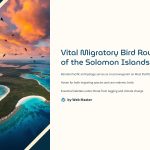 The Solomon Islands, an archipelago rich in biodiversity, serve as a crucial hub for various migratory bird species. These islands not only host endemic birds but also act as significant stopovers and breeding grounds for migratory species traversing the West Pacific Flyway. Understanding these migratory patterns is essential for conservation efforts and offers bird enthusiasts unique opportunities to observe these avian travelers in their natural habitats.
The Solomon Islands, an archipelago rich in biodiversity, serve as a crucial hub for various migratory bird species. These islands not only host endemic birds but also act as significant stopovers and breeding grounds for migratory species traversing the West Pacific Flyway. Understanding these migratory patterns is essential for conservation efforts and offers bird enthusiasts unique opportunities to observe these avian travelers in their natural habitats.

The West Pacific Flyway: A Vital Migration Corridor
The West Pacific Flyway is a major migratory route that extends from the southern reaches of New Zealand and Australia, through the central Pacific, encompassing Papua New Guinea, eastern Indonesia, the Philippines, and up to the Bering and Chukchi Seas near Alaska and easternmost Siberia. The Solomon Islands are strategically positioned within this flyway, making them a critical waypoint for numerous bird species during their seasonal migrations. citeturn0search24

Key Migratory Species in the Solomon Islands
Several notable migratory bird species utilize the Solomon Islands during their journeys:
- Shining Bronze Cuckoo (Chalcites lucidus): Breeds in New Zealand and migrates to the Solomon Islands and other Pacific islands during the non-breeding season. citeturn0search31
- Sacred Kingfisher (Todiramphus sanctus): Found across Australia, New Zealand, and parts of the western Pacific, including the Solomon Islands. These birds migrate northward after breeding to warmer regions, returning south as temperatures rise. citeturn0search28
- Tree Martin (Petrochelidon nigricans): Breeds in Australia and migrates to New Guinea, Indonesia, and the Solomon Islands during the non-breeding season. citeturn0search26

Endemic Birds and Their Movements
The Solomon Islands are home to a remarkable array of endemic bird species, many of which have limited ranges and specific habitat requirements. For instance:
- Kolombangara Leaf Warbler (Phylloscopus amoenus): Confined to the upland forests of Kolombangara Island, this species exemplifies the localized nature of many endemic birds in the archipelago. citeturn0search30
Understanding the movements and habitat needs of these endemic species is vital for their conservation, especially in the face of habitat loss and climate change.

Conservation Challenges and Efforts
Migratory and endemic birds in the Solomon Islands face several threats:
- Habitat Loss: Deforestation for logging and agriculture reduces available habitats for both resident and migratory birds.
- Climate Change: Altered weather patterns can disrupt migration timings and food availability.
Conservation initiatives focus on preserving critical habitats, establishing protected areas, and engaging local communities in sustainable practices to ensure the survival of these bird species.

Birdwatching Opportunities in the Solomon Islands
For bird enthusiasts, the Solomon Islands offer unparalleled opportunities to observe both migratory and endemic species. Prime locations include:
- Kolombangara Island: Known for its rich birdlife, including the Kolombangara Leaf Warbler and other endemics. citeturn0search30
- Rennell Island: Hosts unique species such as the Rennell Shrikebill and offers insights into island endemism.
- Makira Island: Home to several endemic species, making it a must-visit for dedicated birdwatchers.

Best Times for Birdwatching
Timing is crucial for optimal birdwatching experiences:
- Migratory Birds: The best periods are during the migration seasons, typically from September to November and March to May, when species like the Shining Bronze Cuckoo pass through.
- Breeding Seasons: Observing endemic species is particularly rewarding during their breeding seasons, which vary among species but often coincide with specific climatic conditions.
Planning visits around these times increases the likelihood of witnessing a diverse array of bird species.
*Capturing unauthorized images is prohibited*


